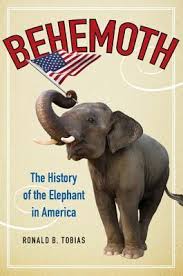Behemoth: The History of the Elephant in America, by Ronald B. Tobias
Harper Perennial (2013), Paperback, 512 pages
I’m a sucker for quirky titles like this, I simply can’t resist a book that promises to shed light on some obscure portion of human knowledge or history. Micro-history is one term that has become popular to describe this type of literature, and I suppose it is as good a way as any to describe this fascinating work, concentrating as it does on the long and peculiar relationship between an animal and a country to which it is not even native. As Tobias reveals, the USA has had a 200 year association with the elephant, beginning with the first specimens to be exhibited in the colonial days, causing such a sensation that the term “seeing the elephant” became ingrained in the language as a term for going out to see the world. Pioneers who ventured out west and soldiers who served in war boasted that they had “seen the elephant”, in other words they had experienced the wonders of the world and returned to tell the tale. The elephant’s size, power, and majesty were seized upon as a symbol of the growing size and confidence of the fledgling United States, even to the extent of maps of the country being depicted in elephant form, with Florida as the trunk, New England as the head and Baja California as the tail. There was serious talk of the elephant being considered as the national symbol of the USA, and although this did not eventuate, the elephant remained an outstanding object of fascination for Americans, to the extent that buildings in the shape of elephants became a fad. However, there was a ugly side to this obsession, which Tobias reveals with unflinching and sometimes horrific detail. To satisfy the public demand for elephants, increasing numbers were brought from both Africa and Asia, and elephants being what they are, very large animals with strong opinions, likes and dislikes, and the wherewithal to impose those feelings on frail humans with crushing power, the inevitable happened. Many keepers, unthinkingly using cruel methods of control on their charges, paid with their lives as previously docile animals were goaded beyond toleration and went on killing sprees. The end result was as unfortunate for the elephant as it was for the humans, because dangerous elephants were tagged as criminals and made to pay the same price as human murderers. Tobias lists a horrific catalogue of animals executed by shooting, poisoning, hanging, electrocution (you can see the latter for yourself, it was filmed by Thomas Edison as part of his campaign to prove AC current was more dangerous than his own DC, and it’s a shocker, no pun intended, it’s ghastly to watch. Just Google “Electrocuting an Elephant” if you have a strong stomach). Attempts to breed elephants were no more successful than importing them. No elephant born in the US before 1962 lived past its first birthday, killed by their mothers who had not been properly socialized into caring for young, or through disease or malnutrition due to the ignorance of keepers in the care of infant elephants. Although this part of the book is truly depressing, there are lighter moments. Fads such as elephant baseball and trying to harness elephants to plough fields will bring a smile. The book ends on a hopeful note as concerned citizens throughout the country unite to try and give the remaining elephants in the country, many injured physically or scarred mentally, a decent life in sanctuaries where they can roam free from public attention and socialise with their own kind. This is a great read, it will alternately fascinate, amuse and horrify, but it remains compelling throughout. This is quite a unique book, I don’t think I’ve ever before read such a work on the relationship between an animal and a country to which it is not native, but it is truly absorbing. Wonderful stuff.
9.5/10
